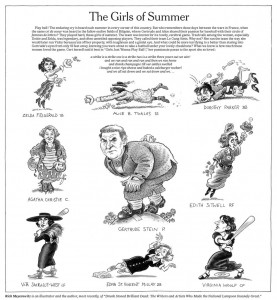Bye-bye 2012!
BYE-BYE SUMMER OF STEIN
The cartoon by Rick Meyerowitz, “The Girls of Summer,” brings home the sad fact. The year-long Summer of Stein ended last year. In May 2012, the last of the big exhibitions on Stein closed. Gertrude – watch out – threw her last ball. Or was that a grenade? Did Meyerowitz see Stein launch a last retort in the controversies that had raged over her political sporting from one summer to another?
If you have a Google Alert set on Stein you know it: All quiet again on the Gertrude front. “Le Gang Stein” (Meyerowitz) is off the field. No more media attacks and daily blog matches. Academe has locked her back into the ivory tower. Quietly the Gertrude Stein Society held a symposium at the Yale Beinecke Library, discussing Stein’s hermetic poetry in Stanzas in Meditation, debating how to teach Stein in the classroom. From political upheaval back to the normal diet of scholarship.
We may have to wait for another decade, another generation, another slew of big media events to bring Stein (and Toklas) back into the limelight.
RECENT SIGHTING OF GERTRUDE STEIN
Meanwhile, in the world of arts and media, sightings of the redisappeared have been reported. I count myself a witness. I spotted Stein in full glory in Robert Wilson’s Einstein on the Beach. How could it be otherwise?
The landmark cultural event of the seventies that was finally revived in 2012, revealed Stein’s inspiration more clearly now than in 1976. The many repetitions of abstract, wonderfully absurd texts in Einstein on the Beach ring in today’s ear like pure Steinese, enhanced by the wonderfully repetitive score of Phil Glass, who knew what he was doing. Less obvious but as striking when you see it: an entire scene of the so-called opera is designed as an homage to Gertrude Stein. I pointed it out in my review of the piece and want to repeat it here:
“Without Stein’s inspiration, another scene in Einstein would in fact be unthinkable. The scene is called The Building. A toy-like house-front shows a woman in a “tower” window, counting with her hands. Below her window, one by one, men gather in the street, and just stand there for some length of time, not doing much of nothing, until again one by one, they leave and the scene is over. Stein: “It is a much more impressive thing to any one to see any one standing, that is not in action than acting or doing anything doing anything being a successive thing, standing not being a successive thing but being something existing. That is then the difference between narrative as it has been and narrative as it is now.” (Narration, 1935)
The congruency between the repetitive happening-not-happening onstage and the repetitive happening-not-happening in the music creates a “being something existing” that is hard to define, but is thrilling in its hypnotic presence. I felt both strained and elated coming out of the theater. Thrilled to witness that this new narrative of then is still the narrative par excellence of now.”
Other sighting are to be reported in the next blog. Stay tuned.





